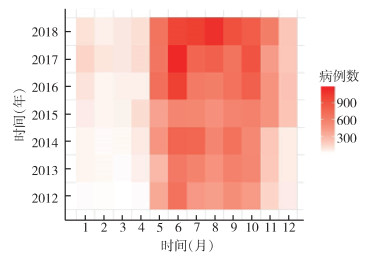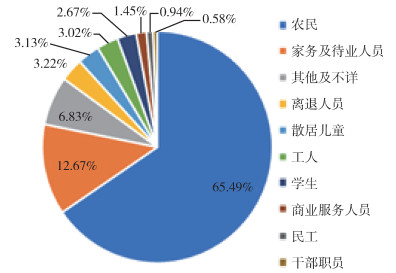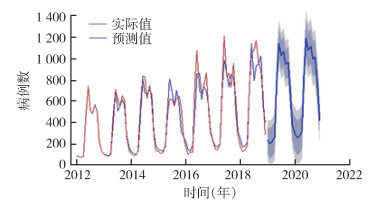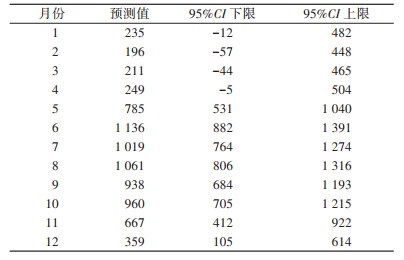扩展功能
文章信息
- 李文, 马德龙, 赵嘉欣, 母群征, 李贵昌, 刘小波, 王君, 张钦凤, 刘起勇, 鲁亮
- LI Wen, MA De-long, ZHAO Jia-xin, MU Qun-zheng, LI Gui-chang, LIU Xiao-bo, WANG Jun, ZHANG Qin-feng, LIU Qi-yong, LU Liang
- 广东省恙虫病流行特征及发病风险预测
- Epidemiological characteristics and risk prediction of scrub typhus in Guangdong province, China
- 中国媒介生物学及控制杂志, 2021, 32(3): 334-338
- Chin J Vector Biol & Control, 2021, 32(3): 334-338
- 10.11853/j.issn.1003.8280.2021.03.015
-
文章历史
- 收稿日期: 2020-12-15
2 山东第一医科大学公共卫生学院, 山东 泰安 271016
2 School of Public Health, Shandong First Medical University, Tai'an, Shandong 271016, China
恙虫病(scrub typhus)是由恙虫病东方体引起的一种急性发热性媒介生物传染病[1]。以鼠类为主要宿主动物,经由恙螨幼虫叮咬传播,其临床表现主要为发热、焦痂、淋巴结肿大等,严重者可致死[2]。恙虫病是亚太地区严重的公共卫生问题,威胁该地区超过10亿人的健康,据世界卫生组织(WHO)估计每年有100万人患病[3-4]。中国是恙虫病负担较严重的国家之一,中国南方地区有约1.62亿人处于潜在感染风险区[5]。2006-2018年广东省报告恙虫病病例和发病县(区)最多,分别为39 968例和139个[6],是我国恙虫病的主要流行省份之一。建立有效的恙虫病预测预警系统,可为制定恙虫病防治策略及效果评价提供科学依据。本研究旨在分析广东省2012-2018年恙虫病的流行病学特征,并使用自回归积分移动平均(autoregressive integrated moving average,ARIMA)模型预测2020年广东省恙虫病的病例数,为制定恙虫病防控措施提供科学依据。
1 材料与方法 1.1 数据来源2012年1月1日至2019年12月31日恙虫病病例数据来源于中国疾病预防控制中心传染病报告信息管理系统,病例数据包括现住址、发病时间、确诊病例类型等。
1.2 统计学分析采用Excel 2016软件建立数据库,对病例资料进行分类整理,剔除疑似病例和信息不全的病例,运用SPSS 22.0软件对数据进行统计分析,率的比较采用χ2检验,检验水准α=0.05。
1.3 ARIMA模型基于ARIMA理论,使用R 4.0.2软件构建预测模型。ARIMA模型是一种经典的时间序列分析方法,其基本思想是对时间序列进行观察研究,从序列自相关的角度找出内在规律,利用其变化规律来预测将来的情况[7]。恙虫病月发病时间序列为季节性时间序列,故采用乘积季节模型,即ARIMA(p,d,q)×(P,D,Q)s。其中d为平稳化过程中差分的阶数,p、q为自回归和移动平均阶数。P、Q为季节性自回归和移动平均阶数,D为季节差分阶数,s为季节周期。
建模过程按照以下阶段进行[8]:(1)序列特征及平稳化:首先做白噪声检验(Box-Pierce)验证序列是否为随机序列,应用时间序列图、自相关系数函数图(ACF图)、偏自相关系数函数图(PACF图)分析序列特征(趋势性、季节性)及平稳性,使用ADF(Augmented Dickey-Fuller)统计检验验证序列平稳性。若序列平稳,进行平稳序列的时间序列分析;若序列不平稳,结合序列特征,采用合适的数据预处理方法,包括数据转换、普通差分、季节差分等,实现序列平稳化后进行分析。(2)模型的识别:根据ACF图、PACF图和R语言forecast包进行定阶,进行模型的初步识别和定阶。(3)参数估计及模型诊断:利用非线性最小二乘法估计模型参数。参数估计后,对模型的残差序列进行白噪声检验(Ljung-Box test),用以判断模型的适合性。依据赤池信息量准则(akaike information criterion,AIC)和贝叶斯信息准则(bayesian information criterions,BIC)确定模型阶数,如不恰当则返回第二阶段,重新选定模型。(4)预测应用及模型评价:利用构建的ARIMA模型,预测2019年及2020年1-12月广东省恙虫病的发病情况,利用组内相关系数(intraclass correlation coefficient,ICC)对2019年的预测值和实际值进行一致性评价。
2 结果 2.1 流行特征2012-2018年广东省共报告恙虫病病例33 490例,对月病例数进行季节性分解分析,结果显示,广东省恙虫病病例数逐年增加,存在明显的季节性和周期性(图 1、2),病例数的季节分布呈现双峰分布,主要分布在每年的6-10月,在6、10月分别达到2个高峰,也就是每年的夏秋季(图 3)。2012-2018年广东省恙虫病50~60岁年龄组病例数最多,占病例总数的26.16%,各年龄组男、女性病例数(图 4)差异有统计学意义(χ2=1 255.861,P < 0.001),女性病例多于男性;病例大多数是农民,占发病总数的65.49%。见图 5。

|
| 图 1 广东省2012-2018年恙虫病发病时间序列图 Figure 1 Time series of scrub typhus cases in Guangdong province, 2012-2018 |
| |

|
| 图 2 广东省2012-2018年恙虫病病例数季节性分解图 Figure 2 Seasonal decomposition plot of scrub typhus cases in Guangdong province, 2012-2018 |
| |

|
| 图 3 广东省2012-2018年恙虫病发病逐月分布 Figure 3 Monthly distribution of scrub typhus cases in Guangdong province, 2012-2018 |
| |

|
| 图 4 广东省2012-2018年恙虫病病例年龄、性别分布 Figure 4 Age and sex distributions of scrub typhus cases in Guangdong province, 2012-2018 |
| |

|
| 图 5 广东省2012-2018年恙虫病病例职业分布 Figure 5 Occupational distribution of scrub typhus cases in Guangdong province, 2012-2018 |
| |
经Box-Pierce检验,χ2=48.366,P < 0.001,说明该序列是非随机序列。对于不平稳序列,需要进行差分处理使其平稳化。经一次一般差分和一次季节差分消除了趋势性和季节性的影响,得到了一个近似平稳的随机序列(ADF检验,P < 0.01),自相关分析图和偏相关分析图显示序列已符合ARIMA模型的平稳性要求。
2.2.2 参数判断ACF图中自相关函数1阶显著非0,自相关值突破了可信区间,ACF图、PACF图均拖尾,初步判断ARMA(1,1);季节自相关特征,1阶显著非0,而后迅速截断,自相关系数延迟12阶显著非0;偏自相关1阶显著非0并拖尾,延迟12阶落入2倍标准差以内,大致判断季节性ARMA(0,1)12,因此大致判断ARIMA模型为(1,1,1)(0,1,1)12(图 6)。同时利用R语言auto.arima函数进行自动定阶,最优模型为ARIMA(0,1,2)(0,1,1)12。备选模型的检验结果和参数之间的相关性进行不断调试,根据AIC值和标准化BIC值最小的模型为最佳模型(表 1)。ARIMA(1,1,1)(0,1,1)12的AIC值为870.30,BIC值为879.36,在拟合的所有模型中最小,此时R2=0.902,调整R2=0.377。

|
| 图 6 经一次一般差分、一次季节性差分后自相关与偏相关结果 Figure 6 The autocorrelation function and partial autocorrelation function diagram after first-general difference and first-seasonal difference |
| |
观察残差ACF图和PACF图(图 7),发现延迟阶数均未超出2倍标准差界限,可认为残差序列为白噪声序列;Ljung-Box统计量为0.000 452 16,P= 0.983。

|
| 图 7 残差自相关和偏自相关结果 Figure 7 Residual autocorrelation and partial autocorrelation diagram |
| |
将数据整体回代,由模型拟合图可见(图 8),模型拟合值与实际值基本重合。同时将2019年1-12月恙虫病病例预测值与实际值进行比较,预测结果与实际值比较的平均绝对百分比误差为20.85(表 2)。模型拟合值与实际值的ICC分析结果显示,ICC值为0.934,95%可信区间(CI)为0.629~0.983,F=47.494,P < 0.001。

|
| 注:浅灰色区域为80%预测区间,深灰色区域为95%预测区间。 图 8 ARIMA(1,1,1)(0,1,1)12模型拟合及预测结果 Figure 8 Fitted curve and predictive value of the ARIMA (1, 1, 1)(0, 1, 1)12 model |
| |

|
利用构建的ARIMA模型对2020年每月广东省恙虫病病例进行预测(表 3),可见预测2020年2月病例数最少,5月开始恙虫病病例增加,5-11月病例数较多,呈单峰分布。见图 8。

|
近年来广东省恙虫病发病数和发病县(区)均呈逐年上升趋势,发病主要集中在6-10月,属于典型的“夏季型”疫区[9],发病数的季节分布呈现双峰现象。可能原因是该季节温度较高湿度较大,适合鼠类和恙螨的生长繁殖及生命活动[10],鼠类和恙螨密度增加,发病风险增加。本研究结果显示,发病主要集中在51~60岁年龄组,女性发病例数更多,农民占发病总数的65.49%。李贵昌和刘起勇[11]研究全国恙虫病流行特征发现农民占比最大,孙烨等[12]研究山东、安徽、江苏省恙虫病发现发病人群主要是女性、老年农民,王铁强等[13]研究2006-2012年广东省恙虫病流行特征,发现发病人群主要集中在40~65岁,女性病例更多,农民占比59.30%。本研究结果与上述结果一致,可能的原因:(1)恙虫病主要发生在农村地区,农民从事户外活动,与恙螨接触概率大,发病风险高。(2)随着人口老龄化,中老年人数数量增加,许多中老年人群参与户外休闲活动,感染恙虫病风险增加[14]。
3.2 ARIMA模型效果评价建立有效的传染病预测预警模型,对于有效防控传染病的发生发展具有重要意义,ARIMA模型是时间序列分析中一种常用的模型,能够较好地描述时间序列的变动情况,适用于具有典型趋势特征变化数据的预测[15]。恙虫病是一种由恙螨幼虫叮咬传播的媒介生物传染病,其发病具有明显的季节性和周期性,而ARIMA模型考虑了季节因素对时间平稳性的影响,可以用于对恙虫病发病的预测。王太武等[16]、颜玉炳等[17]分别使用ARIMA模型预测华东地区某部、厦门市恙虫病发病情况,模型预测效果较好。ARIMA模型要求时间序列长度在30个数据以上[18],本研究以2012-2018年84个月的发病数据建立模型,对2019年12个月的发病数进行预测并与实际值进行比较,同时预测2020年的发病情况。模型整体回代显示,与实际发病情况基本一致,预测结果显示,发病仍主要集中在6-10月;2019年预测值与实际值比较,总体来看,预测值与实际值变化趋势基本一致,且实际值基本位于预测值的95%CI以内,提示ARIMA模型能够较好地预测广东省恙虫病病例的变化情况。
利益冲突 无
| [1] |
Elliott I, Pearson I, Dahal P, et al. Scrub typhus ecology: a systematic review of Orientia in vectors and hosts[J]. Parasit Vectors, 2019, 12(1): 513. DOI:10.1186/s13071-019-3751-x |
| [2] |
Taylor AJ, Paris DH, Newton PN. A systematic review of mortality from untreated scrub typhus (Orientia tsutsugamushi)[J]. PLoS Negl Trop Dis, 2015, 9(8): e0003971. DOI:10.1371/journal.pntd.0003971 |
| [3] |
Kelly DJ, Fuerst PA, Ching WM, et al. Scrub typhus: the geographic distribution of phenotypic and genotypic variants of Orientia tsutsugamushi[J]. Clin Infect Dis, 2009, 48(Suppl 3): S203-230. DOI:10.1086/596576 |
| [4] |
Kwak J, Kim S, Kim G, et al. Scrub typhus incidence modeling with meteorological factors in South Korea[J]. Int J Environ Res Public Health, 2015, 12(7): 7254-7273. DOI:10.3390/ijerph120707254 |
| [5] |
Zheng CJ, Jiang D, Ding FY, et al. Spatiotemporal patterns and risk factors for scrub typhus from 2007 to 2017 in Southern China[J]. Clin Infect Dis, 2019, 69(7): 1205-1211. DOI:10.1093/cid/ciy1050 |
| [6] |
岳玉娟, 王玉姣, 李贵昌, 等. 2006-2018年中国大陆恙虫病高发区流行病学特征分析[J]. 疾病监测, 2020, 35(4): 301-306. Yue YJ, Wang YJ, Li GC, et al. Epidemiological characteristics of scrub typhus in high-incidence areas in the mainland of China, 2006-2018[J]. Dis Surveil, 2020, 35(4): 301-306. DOI:10.3784/j.issn.1003-9961.2020.04.007 |
| [7] |
潘衍宇, 吴海霞, 国佳, 等. 基于R语言自回归积分移动平均模型的广州市白纹伊蚊密度预测研究[J]. 中国媒介生物学及控制杂志, 2018, 29(6): 545-549. Pan YY, Wu HX, Guo J, et al. Population density prediction of Adeds albopictus in Guangzhou based on autoregressive integrated moving average model[J]. Chin J Vector Biol Control, 2018, 29(6): 545-549. DOI:10.11853/j.issn.1003.8280.2018.06.001 |
| [8] |
张文彤. SPSS统计分析高级教程[M]. 北京: 高等教育出版社, 2004: 266-267. Zhang WT. Advanced course of SPSS statistical analysis[M]. Beijing: Higher Education Press, 2004: 266-267. |
| [9] |
吴光华. 我国恙虫病流行病学研究现状与展望[J]. 中华传染病杂志, 2000, 18(2): 142-144. Wu GH. Current situation and prospect of epidemiological research on scrub typhus in China[J]. Chin J Infect Dis, 2000, 18(2): 142-144. DOI:10.3760/j.issn:1000-6680.2000.02.033 |
| [10] |
黎家灿, 王敦清, 陈兴保. 中国恙螨: 恙虫病媒介和病原体研究[M]. 广州: 广东科技出版社, 1997: 6. Li JC, Wang DQ, Chen XB. Trombiculid mites of China[M]. Guangzhou: Guangdong Science and Technology Press, 1997: 6. |
| [11] |
李贵昌, 刘起勇. 恙虫病的流行现状[J]. 疾病监测, 2018, 33(2): 129-138. Li GC, Liu QY. Epidemic trend of scrub typhus in the world[J]. Dis Surveil, 2018, 33(2): 129-138. DOI:10.3784/j.issn.1003-9961.2018.02.006 |
| [12] |
孙烨, 方立群, 曹务春. 山东、安徽、江苏省2006-2013年秋冬型恙虫病流行特征及影响因素研究[J]. 中华流行病学杂志, 2016, 37(8): 1112-1116. Sun Y, Fang LQ, Cao WC. Study on the epidemiological characteristics and influencing factors of scrub typhus in the autumn-winter natural foci, from 2006 to 2013[J]. Chin J Epidemiol, 2016, 37(8): 1112-1116. DOI:10.3760/cma.j.issn.0254-6450.2016.08.012 |
| [13] |
王铁强, 姚云英, 黄喜强, 等. 2006-2012年广东省恙虫病流行特征分析[J]. 中华地方病学杂志, 2014, 33(4): 429-432. Wang TQ, Yao YY, Huang XQ, et al. Characteristics of scrub typhus epidemic in Guangdong province from 2006 to 2012[J]. Chin J Endemiol, 2014, 33(4): 429-432. DOI:10.3760/cma.j.issn.2095-4255.2014.04.021 |
| [14] |
王桦, 赵晟珣, 曾尔亢, 等. 中国人口老龄化社会发展与应对策略[J]. 中国社会医学杂志, 2014, 31(2): 75-77. Wang H, Zhao SX, Zeng EK, et al. The social development and the coping strategies for China's aging population[J]. Chin J Soc Med, 2014, 31(2): 75-77. DOI:10.3969/j.issn.1673-5625.2014.02.001 |
| [15] |
胡跃华, 廖家强, 冯国双, 等. 自回归移动平均模型在全国手足口病疫情预测中的应用[J]. 疾病监测, 2014, 29(10): 827-832. Hu YH, Liao JQ, Feng GS, et al. Application of multiple seasonal autoregressive integrated moving average model in prediction of incidence of hand foot and mouth disease in China[J]. Dis Surveil, 2014, 29(10): 827-832. DOI:10.3784/j.issn.1003-9961.2014.10.018 |
| [16] |
王太武, 韩一芳, 张琪, 等. 华东地区某部恙虫病流行特征及发病趋势预测预警研究[J]. 中华卫生杀虫药械, 2019, 25(2): 128-131. Wang TW, Han YF, Zhang Q, et al. Epidemic characteristics and forecast of scrub typhus in a certain system of eastern China[J]. Chin J Hyg Insect Equip, 2019, 25(2): 128-131. DOI:10.19821/j.1671-2781.2019.02.011 |
| [17] |
颜玉炳, 郭志南, 陈小平. 厦门市恙虫病流行特征及发病趋势预测效果研究[J]. 中华卫生杀虫药械, 2016, 22(3): 262-265. Yan YB, Guo ZN, Chen XP. Epidemic characteristics and prediction effect of scrub typhus in Xiamen city[J]. Chin J Hyg Insect Equip, 2016, 22(3): 262-265. DOI:10.19821/j.1671-2781.2016.03.017 |
| [18] |
王丙刚, 曲波, 郭海强, 等. 传染病预测的数学模型研究[J]. 中国卫生统计, 2007, 24(5): 536-540. Wang BG, Qu B, Guo HQ, et al. Study of mathematical models for the prediction of infectious diseases[J]. Chin J Heal Stats, 2007, 24(5): 536-540. DOI:10.3969/j.issn.1002-3674.2007.05.028 |
 2021, Vol. 32
2021, Vol. 32



